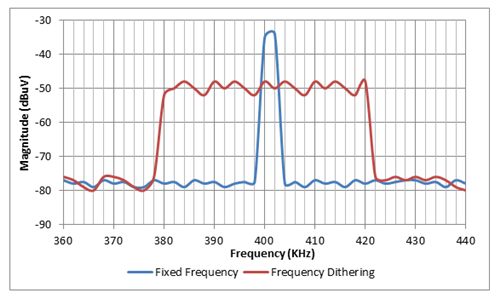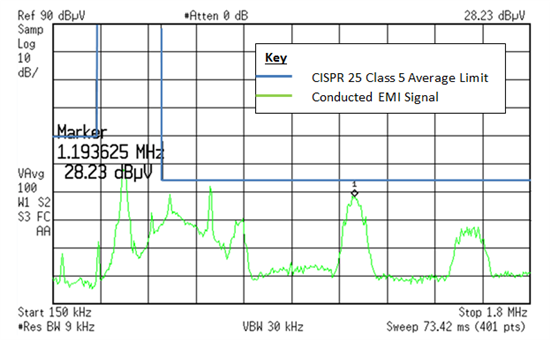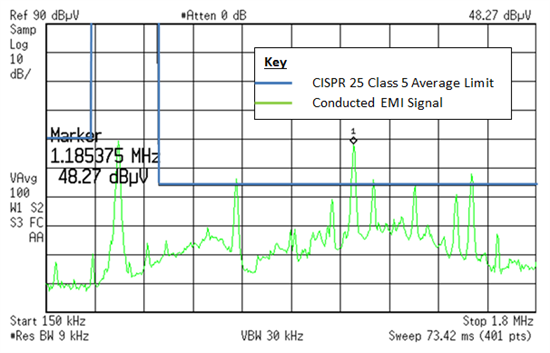SSZTBN1 February 2016 LM5088

An automobile design engineer approached our team recently with an issue: he was unable to meet the Comité International Spécial des Perturbations Radioélectriques (CISPR) 25 Class 5 electromagnetic interference (EMI) standard during conducted EMI measurements for a fixed-frequency buck regulator they designed. Let me briefly go over some of the aforementioned EMI terms:
- EMI is the unwanted coupling of signals from one circuit to another, or to the system. EMI is associated with any switched-mode power supply (SMPS) because of drastic voltage transitions, diode reverse-recovery currents and the oscillations of the passive parasitic.
- Conducted EMI is coupling via conduction through the parasitic impedance, power and ground connections.
- CISPR 25 is an EMI standard. EMI standards may vary depending on geographical region and application. Class 5 is the most stringent subcategory of the CISPR 25 standard.
The design engineer tried filtering and optimizing the layout, but he was still failing to meet CISPR 25 Class 5’s average limits by a few decibels microvolt. Average limits are generally 20dB more stringent than peak limits for all CISPR 25 classes except for TV bands (41MHz and above). Here, they were meeting the peak limits with plenty of margin.
Since the engineer mentioned that he barely missed the average limits using a fixed-frequency buck converter, frequency dithering (also known as spread-spectrum) devices came to mind.
In a fixed-frequency switching converter, the emissions are concentrated at the switching frequency and its harmonics. The average emission is very close to peak. Conversely, a frequency dithering-enabled switching converter spreads the emissions over a range of frequencies (usually ±5% of the switching frequency); hence, the emissions are not concentrated at a particular frequency. This does not actually reduce the peak-noise energy levels, but the average levels are reduced by roughly the ratio of the width of the spread spectrum to the 9kHz (for all measurements below 30MHz) EMI receiver bandwidth. In terms of decibel measurements, the reduction is roughly 10 times the log of bandwidth ratio. For example, noise spread over an 80kHz bandwidth will show about a 9dB reduction with a 9kHz bandwidth receiver.
 Figure 1 Conducted Emissions Comparison
between Fixed-frequency and Frequency Dithering
Figure 1 Conducted Emissions Comparison
between Fixed-frequency and Frequency DitheringOur team decided to design with the LM5088, a nonsynchronous buck controller with both frequency dithering and fixed-frequency capability. After building and testing the functionality of the evaluation board, we took conducted EMI measurements over the range of 150kHz to 1.8MHz (covering the main AM bands). Figure 2 is the spectrum analyzer screenshot.
 Figure 2 Frequency Dithering Helps Meet
the CISPR 25 EMI Standard, as the Signal Is Well below the Average Limit
Figure 2 Frequency Dithering Helps Meet
the CISPR 25 EMI Standard, as the Signal Is Well below the Average LimitFrom Figure 2, you can see that the average emissions (in green) are below CISPR 25 Class 5’s average limits (in blue). The maximum peak is 28.23dBµV at 1.19MHz and the average limit is 34dBµV for that frequency band, leaving considerable headroom.
To ensure that frequency dithering is what’s helping satisfy the EMI standards, we disabled frequency dithering, enabled fixed frequency and repeated the conducted EMI tests. See Figure 3.
 Figure 3 The Fixed-frequency LM5088
Fails to Meet CISPR 25 Class 5, as at Least Three Peaks Exceed the Limit
Figure 3 The Fixed-frequency LM5088
Fails to Meet CISPR 25 Class 5, as at Least Three Peaks Exceed the LimitFigure 3 shows at least three violations. The maximum peak is 48.27dBµV at 1.18MHz, which is about 14dBµV higher than the CISPR 25 Class 5 average limit, thus failing to meet the standard.
If you take a closer look at Figure 2, the frequency dithering-enabled LM5088 took the peak at 1.18MHz and spread it over a small range of frequencies, which brought the peak of the average signal down.
This is a good example of when only average limits are violated, frequency dithering alone can bring your conducted EMI into compliance. Other devices like the LM5088 have a frequency dithering feature that can help meet EMI specifications for your designs.